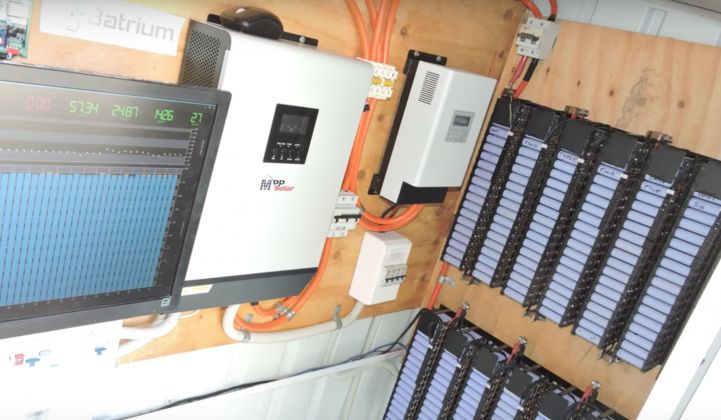A growing cadre of do-it-yourself enthusiasts is turning its attention to residential energy storage.
For these aficionados, Tesla's $3,000 Powerwall fails to impress. Instead, they're building their own DIY versions -- for a fraction of the cost.
Jehu Garcia, Peter Matthews and Daniel Römer are leaders in a movement that uses social media to show how you can build home battery packs from laptop batteries.
Garcia, whose YouTube channel has almost 113,000 subscribers, is working on an industrial-scale DIY battery system with 1 megawatt-hour of storage capacity. His video announcement of the project has been viewed more than 91,000 times.
Garcia first shared how to build a homemade version of Tesla’s Powerwall in 2016. Although he never completed the project, he inspired other YouTubers to follow suit.
One was Australian Peter Matthews, who runs a forum called DIY Powerwalls. In August, he showed off a 40-kilowatt-hour homemade battery storage system, assembled from 4,480 18650-sized lithium-ion cells, to the 23,000 subscribers on his YouTube channel.
Elsewhere on the internet, Daniel Römer, who runs a website called DIY Tech & Repairs that has more than 5,000 YouTube followers, offers lessons on how to arrange the 18650 model cells into packs that can be used for home storage.
Until Garcia makes good on his plans for a 1 megawatt-hour battery system, Römer appears to hold the honor of having created the world’s largest self-made energy storage system, with more than 100 kilowatt-hours of capacity.
Other YouTube battery guides include Mike's DIY Tesla Powerwall, where viewers get to see the savings from an amateur solar-plus-storage setup, and AveRage Joe, run by Joe Williams, which showcases attempts to get a 10-kilowatt system to run for 24 hours.
YouTube is just one of several channels where battery-building aficionados congregate. A DIY Powerwalls Facebook page, also run by Matthews, counts more than 7,100 members.
The cost of building your own version of the Powerwall naturally depends on a range of variables, from the parts used to the storage capacity. In a video posted in 2015 and viewed more than a million times, Garcia claimed he could build a DIY Powerwall for $300.
The U.K. DIY Powerwall YouTube channel, meanwhile, puts the cost at $900. Despite these cost reductions, it is unlikely the DIY Powerwall YouTubers will prompt a wave of amateur energy storage system production.
Getting hold of the cells -- from old laptops bought off of eBay, for example -- is a chore. “When they come to me, they’re just laptop batteries,” explains Matthews in a video. “They’re dead. Typically, they don’t charge anymore.”
Usually the reason is that one or maybe more of the cells has failed. Checking whether they are in working order can take around an hour per cell. “It’s a very labor-intensive process,” explains Matthews.
Then you need to assemble the battery system, which includes making some sort of box or enclosure to put it in. YouTubers espousing custom-built battery systems typically have a well-stocked assembly room or workshop to play in.
What they end up with is sometimes big enough to fill a small shed and nowhere near a real Powerwall in terms of design or aesthetics. Looks aside, there's also an issue of safety.
"DIY energy storage is not something we would encourage due to the inherent dangers associated with electricity and batteries,” said Nick Jenkey at Dulas, a specialist renewable energy advisory firm.
“We have seen examples where domestic energy producers have attempted to build 'Powerwalls' using old laptop 18650 cells," he said. "However, it is highly inadvisable for anyone, even a skilled engineer, to assemble a large-capacity lithium-ion battery from secondhand or even new components.”
In addition to the dangers associated with electricity and high voltages, lithium cells contain flammable organic solvents and may catch fire if mistreated, Jenkey noted.
“In the case of a large battery, the resulting blaze would be very serious and potentially life-threatening,” he said.
That is why, according to GTM Research energy storage analyst Brett Simon, “DIY energy storage will likely remain the purview of a few devoted hobbyists, rather than a trend that will disrupt the market."
“Furthermore, as residential storage becomes increasingly mainstream, consumers are far more likely to purchase a trusted brand with a warranty rather than attempt to build their own system," he added.




